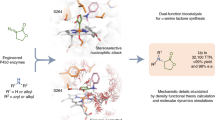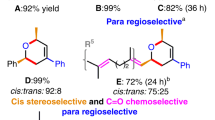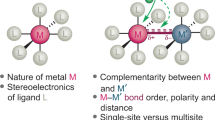Abstract
Reactivity principles based on orbital overlap and bonding/antibonding interactions are well established to describe the reactivity of organic species, and atomic structures are typically predicted by Hund's rules to have maximum single-electron occupancy of degenerate orbitals in the ground state. Here, we extend the role of exchange to transition states and discuss how, for reactions and kinetics of bioinorganic species, the analogue of Hund's rules is exchange-controlled reactivity. Pathways that increase the number of unpaired and spin-identical electrons on a metal centre will be favoured by exchange stabilization. Such exchange-enhanced reactivity endows transition states with a stereochemistry different from that observed in cases that are not exchange-enhanced, and is in good agreement with the reactivity observed for iron-based enzymes and synthetic analogues. We discuss the interplay between orbital- and exchange-controlled principles, and how this depends on the identity of the transition metal, its oxidation number and its coordination sphere.
This is a preview of subscription content, access via your institution
Access options
Subscribe to this journal
Receive 12 print issues and online access
$259.00 per year
only $21.58 per issue
Buy this article
- Purchase on Springer Link
- Instant access to full article PDF
Prices may be subject to local taxes which are calculated during checkout



Similar content being viewed by others
Change history
18 April 2012
In the version of this Article originally published, in Fig. 1d the energy levels 4P and 6P were interchanged. Also, the start of the final sentence of the section "Interplay of exchange and orbital promotion energies" should have read: "Finally, S= 5/2 becomes virtually degenerate with the ground state...". These errors have been corrected in the online versions of the Article.
References
Woodward, R. B. & Hoffmann, R. The Conservation of Orbital Symmetry (Verlag Chemie, 1970).
Fukui, K., Yonezawa, T. & Shingu, H. A molecular orbital theory of reactivity in aromatic hydrocarbons. J. Chem. Phys. 20, 722–725 (1952).
Shaik, S. & Hiberty, P. C. A Chemist's Guide to Valence Bond Theory (Wiley, 2008).
de Jong, G. T. & Bickelhaupt, F. M. Transition-state energy and position along the reaction coordinate in an extended activation strain model. ChemPhysChem 8, 1170–1181 (2007).
Hirao, H., Kumar, D., Thiel, W. & Shaik, S. Two states and two more in the mechanisms of hydroxylation and epoxidation by cytochrome P450. J. Am. Chem. Soc. 127, 13007–13018 (2005).
Kumar, D., Hirao, H., Que, L. Jr & Shaik, S. Theoretical investigation of C–H hydroxylation by (N4Py)FeIVO2+: An oxidant more powerful than P450? J. Am. Chem. Soc. 127, 8026–8027 (2005).
Hirao, H., Kumar, D., Que, L. Jr & Shaik, S. Two-state reactivity in alkane hydroxylation by non-heme iron-oxo complexes. J. Am. Chem. Soc. 128, 8590–8606 (2006).
Shaik, S., Hirao, H. & Kumar, D. Reactivity of high-valent iron–oxo species in enzymes and synthetic reagents: A tale of many states. Acc. Chem. Res. 40, 532–542 (2007).
Janardanan, D., Wang, Y., Schyman, P., Que, L. Jr. & Shaik, S. The fundamental role of exchange-enhanced reactivity in C–H activation by S = 2 oxo iron(IV) complexes. Angew. Chem. Int. Ed. 49, 3342–3345 (2010).
de Visser, S. P. Propene activation by the oxo–iron active species of taurine/α-ketoglutarate dioxygenase (TauD) enzyme. How does the catalysis compare to heme-enzymes? J. Am. Chem. Soc. 128, 9813–9824 (2006).
Johansson, A. J., Blomberg, M. R. A. & Siegbahn, P. E. M. Quantum chemical modeling of the oxidation of dihydroanthracene by the biomimetic nonheme iron catalyst [(TMC)FeIV(O)]2+. J. Phys. Chem. C. 111, 12397–12406 (2007).
Bernasconi, L., Louwerse, M. J. & Baerends, E. J. The role of equatorial and axial ligands in promoting the activity of non-heme oxidoiron(IV) catalysts in alkane hydroxylation. Eur. J. Inorg. Chem. 3023–3033 (2007).
Wang, Y. & Han, K. Steric hindrance effect of the equatorial ligand on Fe(IV)O and Ru(IV)O complexes: a density functional study. J. Biol. Inorg. Chem. 351–359 (2010).
Ye, S. & Neese, F. Quantum chemical studies of C–H activation reactions by high-valent nonheme iron centers. Curr. Opin. Chem. Biol. 13, 89–98 (2009).
Dhuri, S. N. et al. Experiment and theory reveal the fundamental difference between two-state and single-state reactivity patterns in nonheme FeIV=O versus RuIV=O oxidants. Angew. Chem. Int. Ed. 47, 3356–3359 (2008).
Cho, K.-B., Shaik, S. & Nam, W. Theoretical predictions of a highly reactive non-heme Fe(IV)=O species with a high-spin ground state. Chem. Commun. 46, 4511–4513 (2010).
Hirao, H., Que, L. Jr, Nam, W. & Shaik, S. A two-state reactivity rationale for counter intuitive axial ligand effects on the C–H activation reactivity of nonheme FeIV=O oxidants. Chem. Eur. J. 14, 1740–1756 (2008).
de Visser, S. P. What factors influence the ratio of C–H hydroxylation versus C=C epoxidation by a nonheme cytochrome P450 biomimetic? J. Am. Chem. Soc. 128, 15809–15818 (2006).
Decker, A. et al. Spectroscopic and quantum chemical studies on low-spin FeIV=O complexes: Fe−O bonding and its contributions to reactivity. J. Am. Chem. Soc. 129, 15983–15996 (2007).
Ortiz de Montellano, P. R. (ed.) Cytochrome P450: Structure, Mechanism, and Biochemistry 3rd edn (Kluwer Academic/Plenum, 2005).
Nam, W. High-valent iron(IV)–oxo complexes of heme and non-heme ligands in oxygenation reactions. Acc. Chem. Res. 40, 522–531 (2007).
Que, L. Jr The road to non-heme oxoferryls and beyond. Acc. Chem. Res. 40, 493–500 (2007).
Krebs, C., Fujimori, D. G., Walsh, C. T. & Bollinger, J. M. Jr Non-heme Fe(IV)–oxo intermediates. Acc. Chem. Res. 40, 484–492 (2007).
Sinnecker, S. et al. Spectroscopic and computational evaluation of the structure of the high-spin Fe(IV)–oxo intermediates in taurine: α-ketoglutarate dioxygenase from Escherichia coli and its His99Ala ligand variant. J. Am. Chem. Soc. 129, 6168–6179 (2007).
Kovaleva, E. G., Neibergall, M. B., Chakrabatry, S. & Lipscomb, D. J. Finding intermediates in the O2 activation pathways of non-heme iron oxygenases. Acc. Chem. Res. 40, 475–483 (2007).
Murray, L. J. & Lippard, S. J. Substrate trafficking and dioxygen activation in bacterial multicomponent monooxygesases. Acc. Chem. Res. 40, 466–474 (2007).
Neidig, M. L. et al. Spectroscopic and electronic structure studies of aromatic electrophilic attack and hydrogen-atom abstraction by non-heme iron enzymes. Proc. Natl Acad. Sci. USA 103, 12966–12973 (2006).
Bassan, A., Blomberg, M. R. A. & Siegbahn, P. E. M. Mechanism of dioxygen cleavage in tetrahydrobiopterin-dependent amino acid hydroxylases. Chem. Eur. J. 9, 106–115 (2003).
Xue, G., De Hont, R., Münck, E. & Que, L. Jr Million-fold activation of the [Fe2(μ-O)2] diamond core for C–H bond cleavage. Nature Chem. 2, 400–405 (2010).
Schwarz, H. On the spin-forbiddeness of gas-phase ion–molecule reactions: A fruitful intersection of experimental and theoretical studies. Int. J. Mass. Spectrom. 237, 75–105 (2004).
Carter, E. A. & Goddard, W. A. III Relationships between bond energies in coordinatively unsaturated and coordinatively saturated transition-metal complexes: A quantitative guide for single, double, and triple bonds. J. Phys. Chem. 92, 5679–5683 (1988).
Schilling, J. B., Goddard, W. A. & Beauchamp, J. L. Theoretical studies of transition-metal hydrides. 2. CaH+ through ZnH+. J. Phys. Chem. 91, 5616–5623 (1987).
Carter, E. A. & Goddard, W. A. III Early- versus late-transition-metal-oxo bonds: The electronic structure of VO+ and RuO+. J. Phys. Chem. 92, 2109–2115 (1988).
Filatov, M., Harris, N. & Shaik, S. A theoretical study of electronic factors affecting hydroxylation by model ferryl complexes of cytochrome P-450 and horseradish peroxidase. J. Chem. Soc. Perkin Trans. 2, 399–410 (1999).
Ballhausen, C. J. Quantum mechanics and chemical bonding in inorganic complexes. J. Chem. Educ. 56, 294–297 (1979).
Van Vleck, J. H. Valence strength and the magnetism of complex salts. J. Chem. Phys. 3, 807–813 (1935).
Goddard, W. A. III & Harding, L. B. The description of chemical bonding from ab initio calculations. Annu. Rev. Phys. Chem. 29, 363–396 (1978).
Cornehl, H. H., Heinemann, C., Schröder, D. & Schwarz, H. Gas-phase reactivity of lanthanide cations with hydrocarbons. Organometallics 14, 992–999 (1995).
Carroll, J. J. et al. Gas phase reactions of second-row transition metal atoms with small hydrocarbons: Experiment and theory. J. Phys. Chem. 99, 13955–13969 (1995).
Schultz, R. H., Elkind, J. L. & Armentrout, P. B. Electronic effects in C–H and C–C bond activation: State-specific reactions of Fe+(6D, 4F) with methane, ethane and propane. J. Am. Chem. Soc. 110, 411–423 (1988).
Bushnell, J. E., Kemper, P. R., Maitre, P. & Bowers, M. T. Insertion of Sc+ into H2: The first example of cluster-mediated σ-bond activation by a transition metal center. J. Am. Chem. Soc. 116, 9710–9718 (1994).
Chen, H., Song, J., Lai, W. Z., Wu, W. & Shaik, S. Multiple low-lying states for compound I of P450cam and chloroperoxidase revealed from multireference ab initio QM/MM calculations. J. Chem. Theory Comput. 6, 940–953 (2010).
Chen, H., Lai, W. Z. & Shaik, S. Exchange-enhanced H-abstraction reactivity of high-valent non-heme iron(IV)–oxo from coupled cluster and density functional theories. J. Phys. Chem. Lett. 1, 1533–1540 (2010).
Shaik, S., Lai, W. Z., Chen, H. & Wang, Y. The valence bond way: Reactivity patterns of cytochrome P450 enzymes and synthetic analogs. Acc. Chem. Res. 43, 1154–1165 (2010).
Michel, C. & Baerends, E. J. What singles out the FeO2+ moiety? A density-functional theory study of the methaneto-methanol reaction catalyzed by the first row transition-metal oxide dications MO(H2O)p2+, M = V−Cu. Inorg. Chem. 48, 3628–3638 (2009).
Filatov, M. & Shaik, S. Theoretical investigation of two-state-reactivity pathways of H−H activation by FeO+: Addition−elimination, “rebound”, and oxene-insertion mechanisms. J. Phys. Chem. A 102, 3835–3846 (1998).
Schröder, D., Shaik, S. & Schwarz, H. Two-state reactivity as a new concept in organometallic chemistry. Acc. Chem. Res. 33, 139–145 (2000).
Shaik, S. et al. P450 enzymes: Their structure, reactivity, and selectivity—modeled by QM/MM calculations. Chem. Rev. 110, 949–1017 (2010).
Altun, A., Shaik, S. & Thiel, W. What is the active species of cytochrome P450 during camphor hydroxylation? QM/MM studies of different electronic states of compound I and of reduced and oxidized iron–oxo intermediates. J. Am. Chem. Soc. 129, 8978–8987 (2007).
Wang, D., Zhang, M., Bühlmann, P. & Que, L. Jr Redox potential and C–H bond cleaving properties of a nonheme Fe(IV)=O complex in aqueous solution. J. Am. Chem. Soc. 132, 7638–7644 (2010).
Latifi, R., Bagherzadeh, M. & de Visser, S. P. Origin of the correlation of the rate constant of substrate hydroxylation by nonheme iron(IV)-oxo complexes with the bond-dissociation energy of the C–H bond of the substrate. Chem. Eur. J. 15, 6651–6662 (2009).
Geng, C., Ye, S. & Neese, F. Analysis of reaction channels for alkane hydroxylation by nonheme iron(IV)–oxo complexes. Angew. Chem. Int. Ed. 49, 5717–5720 (2010).
Brandt, P., Norrby, P.-O., Daly, A. M. & Gilheany, D. G. Chromium–salen-mediated alkene epoxidation: A theoretical and experimental study indicates the importance of spin-surface crossing and the presence of a discrete intermediate. Chem. Eur. J. 8, 4299–4307 (2002).
Hess, J. S., Leelasubcharoen, S., Rheingold, A. L., Doren, D. J. & Theopold, K. H. Spin surface crossing in chromium-mediated olefin epoxidation with O2 . J. Am. Chem. Soc. 124, 2454–2455 (2002).
Jin, N. & Groves, J. T. Unusual kinetic stability of a ground-state singlet oxomanganese(V) porphyrin. Evidence for a spin state crossing effect. J. Am. Chem. Soc. 121, 2923–2924 (1999).
De Angelis, F., Jin, N., Car, R. & Groves, J. T. Electronic structure and reactivity of isomeric oxo–Mn(V) porphyrins: Effects of spin-state crossing and pKa modulation. Inorg. Chem. 45, 4268–4276 (2006).
Balcells, D., Raynaud, C., Crabtree, R. H. & Eisenstein, O. The rebound mechanism in catalytic C–H oxidation by MnO(tpp)Cl from DFT studies: electronic nature of the active species. Chem. Commun. 744–746 (2008).
Khenkin, A. M., Kumar, D., Shaik, S. & Neumann, R. Characterization of manganese(V)−oxo polyoxometalate intermediates and their properties in oxygen-transfer reactions. J. Am. Chem. Soc. 128, 15451–15460 (2006).
Abashkin, Y. G., Collins, J. R. & Burt, S. K. (Salen) Mn(III)-catalyzed epoxidation reaction as a multichannel process with different spin states. Electronic tuning of asymmetric catalysis: A theoretical study. Inorg. Chem. 40, 4040–4048 (2001).
Balcells, D., Clot, E. & Eisenstein, O. C–H bond activation in transition metal species from a computational perspective. Chem. Rev. 110, 749–823 (2010).
Song, W. J. et al. Synthesis, characterization, and reactivities of manganese(V)−oxo porphyrin complexes. J. Am. Chem. Soc. 129, 1268–1277 (2007).
Clemmer, D. E., Chen, Y.-M., Khan, F. A. & Armentrout, P. B. State-specific reactions of Fe+ (a6D, a4F) with D2O and reactions of FeO+ with D2 . J. Phys. Chem. 98, 6522–6529 (1994).
Poli, R. & Harvey, J. N. Spin-forbidden chemical reactions of transition metal compounds. New ideas and new computational techniques. Chem. Soc. Rev. 32, 1–8 (2003).
Shaik, S., Danovich, D., Schröder, D. & Schwarz, H. Two-state reactivity in organometallic gas-phase ion chemistry. Helv. Chim. Acta 78, 1393–1407 (1995).
Mayer, J. M. Hydrogen atom abstraction by metal–oxo complexes: Understanding the analogy with organic radical reactions. Acc. Chem. Res. 31, 441–450 (1998).
Sastri, C. V. et al. Axial ligand tuning of a nonheme iron(IV)–oxo unit for hydrogen atom abstraction. Proc. Natl Acad. Sci. USA 104, 19181–19186 (2007).
Acknowledgements
This research is supported by an ISF grant to S.S. (ISF 53/09). Collaborations (since 2005) with L. Que and W. Nam are gratefully acknowledged.
Author information
Authors and Affiliations
Corresponding author
Supplementary information
Supplementary information
Supplementary information (PDF 308 kb)
Rights and permissions
About this article
Cite this article
Shaik, S., Chen, H. & Janardanan, D. Exchange-enhanced reactivity in bond activation by metal–oxo enzymes and synthetic reagents. Nature Chem 3, 19–27 (2011). https://doi.org/10.1038/nchem.943
Published:
Issue Date:
DOI: https://doi.org/10.1038/nchem.943
This article is cited by
-
Enantioselective synthesis of chiral α,α-dialkyl indoles and related azoles by cobalt-catalyzed hydroalkylation and regioselectivity switch
Nature Communications (2024)
-
Precise Detection, Control and Synthesis of Chiral Compounds at Single-Molecule Resolution
Nano-Micro Letters (2023)
-
A theoretical study for spin-dependent hydrogen abstraction by non-heme FeIVO complexes based on DFT potential energy surfaces
Theoretical Chemistry Accounts (2023)
-
First-principles calculations on the micro-solvation of 3d-transition metal ions: solvation versus splitting water
Theoretical Chemistry Accounts (2023)
-
Iron and manganese oxo complexes, oxo wall and beyond
Nature Reviews Chemistry (2020)



